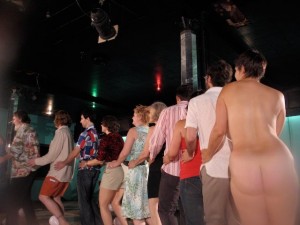Warning: this article contains mild nudity.
David Lynch’s screed against films on cell phones has been largely played for laughs but it speaks to a curious chasm in the film community between a growing weariness with the downgrading of film aesthetics and a genuine enthusiasm for new artistic tools.
This chasm has been widened further by the three corporate interests most invested in cell phone images that move and talk: handset makers, Telcom multinationals and broadcasters.
The phone manufacturers are eager to access the multibillion dollar Home Video industry; the multinationals are hoping to find more things for people to download at a price; and the broadcasters are looking to find cross-platform advertising revenues.
All three see plenty of money in showing films intended for movie theatres on phones, which Lynch most hates, although this is oddly not the focus of their activities. Perhaps they believe they have already won the game on diminishing a large-scale art form to a few inches square. History would seem to back them up. In the past, film distributors insisted that DVDs on home entertainment systems were just as rich an experience as going to film theatres. The exhibitors, slow to catch on, were busy trying to sell an experience involving teen amusements and rococo saturated fats and didn’t see their core business under attack until it was too late.
Instead, the corporations’ focus has been on the production of cell phone films, by professionals and consumers. The handset makers and broadcasters have focused on filmmakers, seeing a logic in how professional image makers have led the consumer to better quality and more expensive cameras. These phone manufacturers emphasize an idea of creative freedom beyond what the phones can actually produce. The Telcoms, on the other hand, see only Kodak Instamatics, celebrating the personal portability of ‘you’ through their services.
This binary sales strategy has resulted in a dizzying amount of work being created in a new medium with virtually no critical response. When half of the business story promotes that films made for cell phones are just for fun and sharing with friends, a curator doesn’t feel like getting into much of a lather. Especially when the industry’s other half isn’t necessarily disputing the claim.
All of this has masked an aesthetic truth: cell phone films look like crap. They contain far less digital information than even the most basic video cameras. For those who think that this yields a charming lo-fi tool – the artistic springboard for a new Fisher Price PXL2000-sporting Sadie Benning – think again. By simply stripping out digital information from work shot with more conventional tools, a similar effect can be engineered with far more artistic control. Despite this fact, money keeps pouring in, with more and more talented filmmakers leaping into the void.
So why are filmmakers so eager to be co-opted into the cell phone film revolution? I asked Guy Maddin, a filmmaker who is famed for his adhesion to cinema’s earliest aesthetic moments and his belief in precise rethinking and recapturing of the medium’s history. It turns out that the secret lies in the third profit participant, the broadcasters.
Maddin has made only one cell phone film, for which he was paid handsomely (by his standards) by BravoFact! An interesting hybrid foundation set up by a broadcaster, BravoFact! has been funding interesting art makers, pushing their work into film festivals with 35mm blowups (which tend to look pretty ghastly) and then broadcasting the films across various platforms. Although they have produced some unusual work, it is doubtless that BravoFact! would not exist without certain peculiarities in the Canadian film funding model which force broadcasters to invest in innovation.
Maddin’s cellphone film was called The Nude Caboose and he credits the freedom of the form (score one point for the handset makers) for sending his work into a new intellectual direction: a more honest and explicit exploration of the pornographic. Quoting the program notes, The Nude Caboose tells the story of how “an enthusiastic man turns an apathetic crowd into a surreal conga line.” The man is pretty much nude and many of the participants become so during its 2:12 length.
In contrast to Maddin’s greatest works like Brand Upon the Brain and The Saddest Music of the World, the short film looks terrible, the framing is off the mark and the central idea seems jejune.
The filmmaker even admits that with The Nude Caboose he was out for bucks and “a joke, a sardonic laugh.”
However, Maddin still finds a way to evoke historicity by exploring the cell phone film’s relationship to discarded technology of the past. The Nude Caboose utilises the primitiveness of the medium to suggest the Vaseline wipe of time and naïve charm of 1960’s home movies. He does this from an artist’s perspective – self-aware and in control of his illusion-making but immersed in process. He explains, “I’m especially charmed by pioneer groupings and that’s just what films made by these first cell phone cameras are! All things primitive simply throw me back into daycare arts and crafts time, the true age of genius for everyone, usually lost to us by the age of eight!” In other words, he rediscovers his childhood Super-8mm (score one for the Telcoms).
Maddin is currently making Keyhole, an ambitious cross-media art project that will be a first for this “pure” filmmaker. Keyhole will feature collage, installation, a feature film and several cell phone films, again with BravoFact! In order to make the project work artistically and financially, Maddin insists he needs “lots of shorts… shorts to sell in limited editions. Porny shorts! I just assume sharper pictures will be required of the phones in the coming months. Then we’ll have a range of fidelities at our disposal – one degree of resolution for each month in the history of the technology – and that these will simply be as brush-sizes at the artist’s disposal. There will be as much range of possibility as there was on display in Lynch’s Inland Empire, more even!”
Maddin sees the diverse corporations and their overlapping marketing strategies as “unknowingly arming the masses. I guess in my heart of hearts I’m hoping a Rimbaud of the cell phone will produce an obvious masterpiece, opening the doors for other talents to follow and that a considerable body of good work will pile up online for free viewing before big business figures out a way of controlling it. Or that perhaps some humane, independent and visionary online distributors will figure out a way of getting these things to interested viewers before the usual corruptions set in.”
Noah Cowan
Noah Cowan is the Artistic Director of Bell Lightbox, a new facility being built in downtown Toronto, devoted to film and its relationship to other media. Cowan was most recently Co-Director of the Toronto International Film Festival and has served as Executive Director and Founder, Global Film Initiative and Co-President, Cowboy Pictures. He has written extensively for newspapers and magazines in North America on culture and cinema.
Watch More
 This work is licensed under a Creative Commons Attribution-NonCommercial-ShareAlike 2.5 Australia.
This work is licensed under a Creative Commons Attribution-NonCommercial-ShareAlike 2.5 Australia.









Very good work, interesting post, bookmarked !